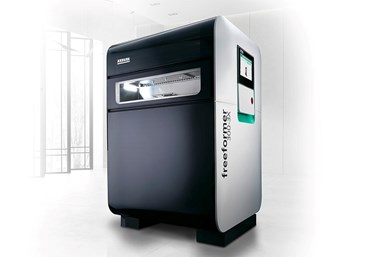Arburg Freeformer Machines Produce Complex, Functional Parts
Rapid + TCT 2022: Arburg’s Freeformer machines feature an open system enabling the properties of the additively manufactured parts to be specifically adapted.
Share
Read Next

Freeformer 300-3X machines are designed to additively manufacture sophisticated functional parts. Photo Credit: Arburg
Arburg’s Freeformer 200-3X and Freeformer 300-3X machines are designed as open systems utilizing the company’s Plastic Freeforming (APF) process for custom-configured additve manufacturing (AM). The system is said to meet individual user requirements by adjusting slicing, droplet size and process regulation to influence the layer-by-layer build process utilizing a broad range of materials.
The Freeformer 200-3X is the standard system which features two discharge units and a print tray with three axes of motion. This system variant can manufacture components with complex geometries from two materials and/or support structures.
The Freeformer 300-3X provides more space inside the build chamber for larger components. It comes with up to three discharge units and a build chamber that is 50% larger for more scope for customization and improved functionality. Its print tray works with three axes of motion that move in combination for greater freedom in the design and dimensioning of parts. It can process high-temperature materials such as ULTEM 9085, which is a permanently flame-retardant and low-smoke material suitable for aerospace applications; as well as biocompatible, resorbable, sterilizable and FDA-approved original materials. The build chamber can be heated to 200°C and can process medically approved PEEK granulate.
The company says optimized temperature management provides the necessary cooling, especially for the axis drives, which can precisely position the part carrier along the X, Y and Z axes. The Freeformer is said to be able to achieve strengths of up to 95% when processing this material in the X and Y directions.
With just a few minor modifications, the system is also suitable for use in clean rooms, the company says. It is said the system can easily produce items that are clean-room compatible, implantable, biocompatible, elastic, lightweight, stable or conductive.
Related Content
-
3D Printing with Plastic Pellets – What You Need to Know
A few 3D printers today are capable of working directly with resin pellets for feedstock. That brings extreme flexibility in material options, but also requires greater knowledge of how to best process any given resin. Here’s how FGF machine maker JuggerBot 3D addresses both the printing technology and the process know-how.
-
3D Printed Lattices Replace Foam for Customized Helmet Padding: The Cool Parts Show #62
“Digital materials” resulting from engineered flexible polymer structures made through additive manufacturing are tunable to the application and can be tailored to the head of the wearer.
-
Concept Sneaker Boasts One-Piece 3D Printed TPU Construction
The Reebok x Botter Concept Sneaker Engineered by HP premiered at Paris Fashion Week, hinting at manufacturing possibilities for the future of footwear.













